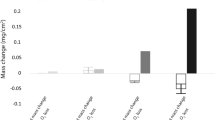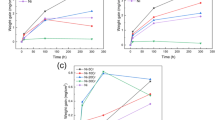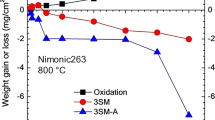Abstract
The Na2SO4-induced accelerated oxidation of nickel-base alloys containing elements such as Cr, Al, Mo, W, and V has been studied in 1.0 atm O2 in the temperature range of 650° to 1000°C. It has been found that the hot corrosion behavior of these alloys can usually be characterized according to one of two types of attack: 1) Na2SO4-induced accelerated oxidation; 2) Na2SO4-induced catastrophic oxidation. In both types of hot corrosion, accelerated oxidation occurs as a result of the formation of a liquid flux based on Na2SC>4 which dissolves the normally protective oxide scales. Catastrophic, or self-sustaining rapid oxidation can occur in alloys which contain Mo, W, or V, because solutions of oxides of these elements with Na2SO4 decrease the oxide ion activity of the molten salts, producing melts which are acidic fluxes for oxide scales. The accelerated oxidation type of attack which was observed with most alloys which did not contain Mo, W, or V, was more severe than for normal oxidation, but much less severe than catastrophic oxidation. Na2SO4-induced accelerated oxidation occurs because the oxide ion activity of the Na2SO4 increases to the point where oxide scales can partially dissolve in the basic melt. Generally, this basic fluxing results from the diffusion of sulfur from the Na2SO4 into the alloy. In some alloys, the formation of sulfides during basic fluxing is a sufficient condition to cause accelerated oxidation. In other alloys, changes in the oxidation mechanism occur because of depletion of the alloy surface, concomitant with basic fluxing, of those elements needed for protective oxide scales, such as aluminum and chromium.
Similar content being viewed by others
References
J. A. Goebel and F. S. Pettit:Met. Tram., 1970, vol. 1, pp. 1943–54.
A.’U. Seybolt:Trans. TMS-AME, 1968, vol. 242, pp. 1955–61.
P. A. Bergman:Corrosion, 1967, vol. 23, pp. 72–81.
N. S. Bornstein and M. A. DeCrescente:Met. Trans., 1971, vol. 2, pp. 2875–83.
A. U. Seybolt: “Na2SO4-Superalloy Corrosion Mechanism Studies,” General Electric Research and Development Center, Report No. 70-C-189, June 1970.
F. S. Pettit:Trans. TMS-AIME, 1967, vol. 239, pp. 1296–1305.
C. S. Giggins and F. S. Pettit:J. Electrochem. Soc., 1971, vol. 118, pp. 1782–90.
C. S. Giggins and F. S. Pettit:Trans. TMS-AIME, 1969, vol. 245, pp. 2495–2507.
J. A. Goebel and F. S. Pettit:Met. Trans., 1970, vol. 1, pp. 3421–29.
B. H. Kear, F. S. Pettit, D. E. Fornwalt, and L. P. Lemaire:Oxidation of Metals, 1971, vol. 3, p. 557.
M. J. N. Pourbaix: “Thermodynamics of Dilute Aqueous Solutions,” Edward Arnold&Co., London, 1949.
H. Pfeiffer and K. Hauffe:Z. Metallk., 1952, vol. 43, pp. 364–68.
H. Davis and H. Graham: Aerospace Research Laboratories, Wright-Patterson Air Force Base, private communication.
F. S. Pettit, J. A. Goebel, and G. W. Coward:Corrosion Sci., 1969, vol. 9, pp. 903–13.
C. T. Brown, N. S. Bornstein, and M. A. DeCrescente: “High Temperature Metallic Corrosion of Sulfur and Its Compounds,” Z. A. Foroulis, ed., Cor-rosion Div. The Electrochem. So., pp. 170-86,1970.
N. S. Bornstein, M. A. DeCrescente, and H. A. Roth: “Effect of Vanadium and Sodium Compounds on Accelerated Oxidation of Nickel-Base Alloys,” Annual Report, Office of Naval Research, Dept. of the Navy, Washington, D. C, Contract N00014-70-C-0234, NR 036-08911-12-70(471).
S. S. Brenner:J. Electrochem. Soc., 1955, vol. 102, pp. 16–21.
E. M. Levin, C. R. Robbins, and H. F. McMurdie: “Phase Diagrams for Ce-ramists,” M. K. Reser, ed., American Ceramic Society, 1964.
J. F. Elliot and M. Gleiser:Thermochemistry for Steelmaking, vol. 1, pp. 190, 201, 253, Addison Wesley Co., Reading, Mass., 1960.
W. J. Cooper and D. A. Scarpiello: Thermodynamic Properties of Metal Bromides, Iodides, Sulfides, Sulfates, Chromàtes, Metaphosphates, Ortho-phosphates, Molybdates, Tungstates, Borates, and Hydroxides, Final Report SC-RR-64-67, Jan. 1964, Callery Chemical Co. to Sandia Corp.
T. Rosenqvist:J. Iron and Steel Inst., 1954, vol. 176, pp. 37–57.
Author information
Authors and Affiliations
Rights and permissions
About this article
Cite this article
Goebel, J.A., Pettit, F.S. & Goward, G.W. Mechanisms for the hot corrosion of nickel-base alloys. Metall Trans 4, 261–278 (1973). https://doi.org/10.1007/BF02649626
Received:
Published:
Issue Date:
DOI: https://doi.org/10.1007/BF02649626




